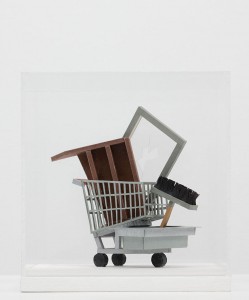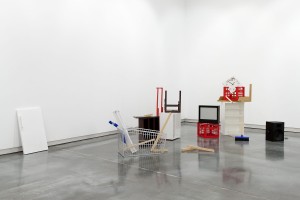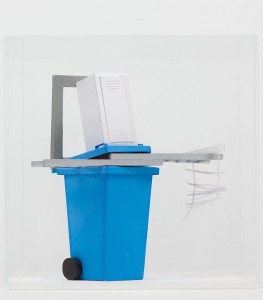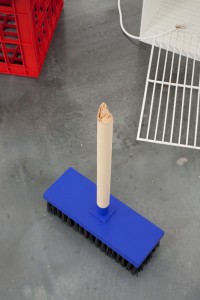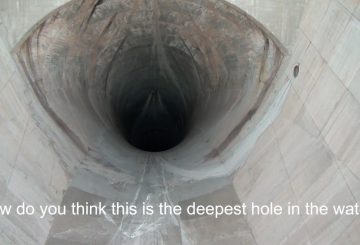Din Heagney spoke to Carly Fischer before her opening night this week at Helen Gory Galerie in Prahran, and asked her about some of the ideas she has developed in her travels from Melbourne to Tokyo to Berlin and back again.
Carly Fischer works in paper. Intricate, precise and deliberately ordinary, her folded sculptures are so perfectly real in their simulation of everyday objects that they are easy to pass by unnoticed. When someone does realise that something is amiss, that they’ve somehow been tricked, there is a tiny moment that opens up, allowing the viewer to question the reality of their environment: if that air vent is fake and that fridge is fake, what else is fake?
Before returning home to Australia from Berlin, Fischer wanted to comment on the whitewash of the Berlin Wall’s East Side Gallery. She began to replace discarded cigarette butts with her own handmade paper replicas. Scattering them like sanitised decoys over the politically corrected ruins, she sat back to watch people’s reactions. Some walked by, others stopped to double take, and a few even picked up the tiny artworks, pocketing them like prized finds.
Paper, foamcore. 16x13x17cms.
It’s this kind of public engagement that Fischer seeks out. The banality of her everyday junk, remade in scaled replicas, exist in a kind of space of not noticing. Fischer’s work is symbolic of the encroaching fakeness of real life, the disposable culture of consumerism, the banal mass-produced stuff that infiltrates daily life. But it’s through Fischer’s remade replicas that we can find a reminder that there might be substance behind the simulacra.
Fischer has returned to Melbourne for six weeks to present two new shows, one at Helen Gory Galerie in Prahran and the other at Gippsland Art Gallery in Sale. Both shows feature her life-sized and scale-model installations made up of perfect paper replicas, where the individual bristles on a broom are actually hundreds of hand-cut paper slithers, and the split wood of a broken handle is made from tiny woven paper sheaths.
I heard it from my friends about the things you said, includes a number of new miniature collector pieces, alongside her more familiar installation work. In the far corner are piles of hard rubbish, the type any of us would pass on a Sunday evening in the suburbs: some milk crates, an abandoned TV, an old school bar fridge, broken wooden furniture, part of an old shopping trolley – just junk at first glance, but junk perfectly replicated in paper and foamcore.
Paper, foamcore, adhesives, pins and spray paint, life-size models. Dimensions variable.
DH: Apart from the new miniature collectable pieces, how are these works and the installation different your previous works?
CF: My earlier work was about gentrification in major cities. My newer work is more about hard rubbish and street junk in Berlin but these are all related ideas in my practice. The general theme in my work is reproduction, and gentrification is part of that. The idea started in Melbourne but it’s prominent in Berlin and everywhere you go around the world – construction sites. What they’ve done in the last couple of years is incredible.
DH: You’ve discussed this in the past as the fetishisation of history, preserving it while simultaneously destroying it.
CF: Exactly, but at the same time I want my work to be ambiguous. People want to know what’s my stance on gentrification and development but I’m interested in making people think a little bit more. My work can have a strange relationship with the viewer, where it can be endorsing the very thing it’s critiquing. In Berlin, all along the Spree where there were lots of clubs and art spaces, the land been bought up by an American developer and is all going to be knocked down and gentrified. It’s like one of the most vibrant places in Berlin and it will soon be gone. It’s very strange.
Paper, foamcore, adhesives. 19x15x20cms.
DH: This kind of simulation of the everyday and disposed things, these are constants in your work. What is it that attracts you to making these replicas of rubbish?
CF: Movements like Situationism have been a huge influence on me. The method of looking at art and its interaction with the everyday is one of my biggest motivations. Take the Berlin Wall, for instance, the East Side Gallery – I was riding past one night and it was suddenly all white. They’d steamed all the paintings off from 20 years ago, and just whitewashed all these comments from artists and people from the revolution. They later invited artists back to repaint it in bright paints and it looks quite fake now. It’s all about surface, a reproduction of the revolution. A reproduction of culture for tourists, the dereliction and grittiness of Berlin but all cleaned up and reproduced in postcards. People even sell bits of concrete to tourists that are potentially part of the real Berlin Wall, but whether it really is, is another thing. I don’t know – it could just be a piece of concrete from someone’s backyard! I’m also inspired by images, reproductions of dereliction, of construction sites, and these tours that go around Berlin looking at past devastation from the war, but then they look at these empty squat spaces and wastelands that are being cleaned up but tourists pay to go there, so that’s quite surreal.
DH: Are you interested in preserving historical objects or are you more interested in the shifting function of objects and their representation?
CF: I’m definitely interested in the shift but I’m also interested in preserving. When I’m going on about gentrification, I’m not saying that gentrification in itself is a bad thing. I think that cities need to change. Speaking to this older woman from Berlin, where I teach English as a job, we got talking about the Berlin Wall and she was saying: well in a way it’s inevitable and it’s good for Berlin because it’s a city of change so you can’t have it being stagnant. But what I am opposed to is this kind of dismissal or eradication of the emotions or history of what has gone before. This reproduction as only aesthetic – I don’t see why there can’t be integration. Sure, it will take a bit more work but some of these buildings that are artist spaces are really vibrant parts of the community. As with anywhere, I mean it happened in Fitzroy, people move in because of the vibrancy and then seek to slowly eradicate the culture. Berlin has been great because there’s a lot of freedom there and also art is part of everyday life. Whereas I feel that Melbourne has a fantastic art scene but it’s also a little but segregated from the rest of society a lot of the time. I think there needs to be more of a balance, with different people living together a little bit more, whether that can actually happen, we’ll see.
DH: Something that I’m writing about at the moment is that certain cities around the world are starting to look generic and culturally they are becoming a little generic as well; that the art emerging from these places is culturally ‘unrelative’, existing in a kind of non space as an effect of globalisation.
CF: That’s another thing I’m interested in as well. It started in Japan when I was there, these interchangeable objects that they have everywhere, the chain stores, different types of clothes for efficiency. Like Ikea as an idea, but specifically in Japan like the plastic food plates outside every shop, almost as though it’s a theatrical set populated with mass-produced objects that have become part of people’s everyday life without thinking. In this kind of installation, the objects are placeless. They are ‘of Berlin’ in their making, but they could just as easily be found in Melbourne. The kinds of objects aren’t specific. They’re the kind of perfect model, the average symbol. Like the TV is a symbol of a TV object made up from hundreds that I’ve looked at. It’s not a perfect TV like you might buy today, a flat screen or something, but more the kind of object you would see in a junk pile, that represent and symbolise a placeless ideal.
DH: You’re still working with paper but there are more materials you’re using now?
CF: I’m still using paper but I’ve also started using 3mm foamcore sheets. One of the reasons is because it’s more durable and can stand as a larger-scale object, structurally it supports itself better, but also for other installations like the life-size construction site I made. That was made out of thick paper that was scored and cut but I just couldn’t transport it, so it could only be shown in Berlin and I wanted to show it in Gippsland. This was an issue, working with limitations. There was no way I could afford to send all these big sculptures and it would be really fragile so I decided to work in a different way. I decided to remake a lot of it out of foamcore so it could be flat packed and easily transported.
Paper, foamcore, adhesives, MDF base and Perspex box, 70x45x15cms.
DH: So in effect, you’re almost starting to reproduce the very objects, flat packed Ikea type objects that your artwork critiques, sent internationally and assembled on site. I don’t know whether that’s ironic or a circle in your practice.
CF: I think that’s interesting because it didn’t evolve because of that reason but because of reasons of limitation. In the same way that I started making these miniatures (the Throwing it all away series) because I had a tiny studio space and I just couldn’t work on a big scale. The way that my practice is going at the moment, I’d like to continue making objects that are really banal, I’m interested in that fundamentally. I’m interested in the everyday and the peripheral. The next series I’m doing is wrappers, remakes of the litter I find on the streets, like a coke can or a cigarette packet. I’m also really interested in working with public space. I did a series of postcards where I put construction site works on the street and photographed them and printed them as postcards that I then gave out to tourists. But that work was taken off the street as soon as it was photographed. For me it’s a personal thing because it takes so much labour to make to the work that I can’t just leave it on the street. But I think it’s one of the most important and one of the most relevant steps for my practice but it’s going to be difficult.
DH: How do you think people perceive your work?
CF: I think it can work in a gallery quite well – it’s more museumfied, like rare collectibles. The works also become aestheticised at the same time they are commenting on that. I’m also going to start placing my work into actual junk piles for people to collect. Asking the question: how do these works exist as art? If they can be rained on or stepped on then what’s the point of art then? Usually the final work is in the documentation, and the documentation becomes the commodity. Someone by chance comes across something. Is that enough as an art piece? I don’t want the objects to be clumsily made, like they are obviously an art object or a copy. I want them to be close enough to the real thing, where you have to do a double take. I’m interested in that moment where you do realise. Here in a gallery space it’s obvious. In spaces in Berlin, abandoned derelict spaces, a pile of handmade leaves and cigarette butts can easily be overlooked. But people are always overlooking art that is smack bang in front of them anyway, but when people do realise that something isn’t real then it’s like a trigger, and people can really start to notice their environment more. If these banal objects are recreated, then what else is recreated, and that idea is everywhere, from Big Brother to the nightly news. I’m not using that imagery but that’s a big influence.
DH: Natasha Frisch who works in paper and who you’ve shown with previously, made a paper chair in an exhibition recently that was so lifelike that someone sat on it accidentally and destroyed the work. A whole discussion started around that as a mark of the work’s success. How do you see your work affecting engagement and behaviour around art?
CF: Working with temporal materials, they’re just not made to last. I’ve made them to look like commodities that are made to last but even then they’re not going to, they’re only made out of paper and they’re very fragile sculptures. Like the Joseph Beuys works that are ridiculous to try to preserve, yet preserve them they do. This idea of things lasting, as art objects, is quite interesting, because most of the rest of life just doesn’t.
CARLY FISCHER
www.carlyfischer.com
I heard it from my friends about the things you said
25 August – 18 September 2010
Helen Gory Galerie
25 St Edmonds Rd Prahran
www.helengory.com
Time stands still when I think of you
20 August – 3 October 2010
Gippsland Art Gallery
68 Foster Street, Sale
www.wellington.vic.gov.au
